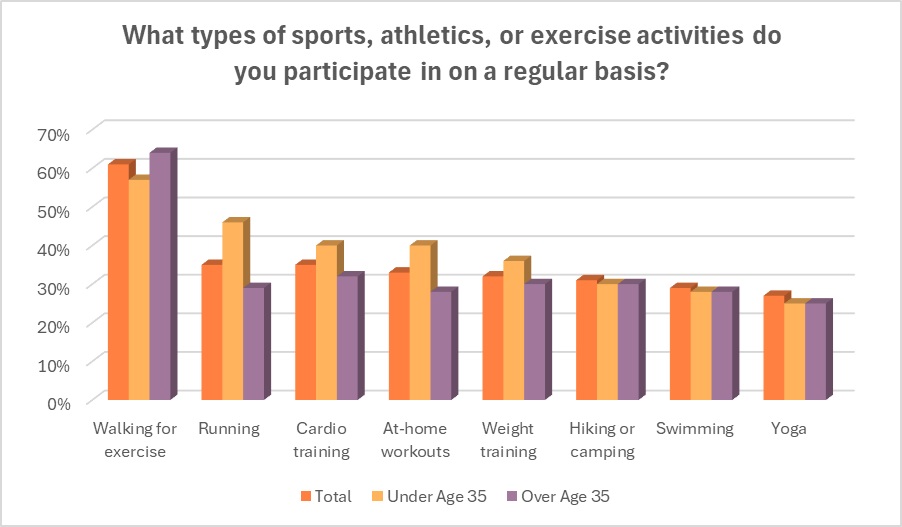More people than ever are enjoying the Great Outdoors. And companies are responding with products that help consumers get back to nature while enjoying natural fibers, be it in their apparel, their gear, or their accessories.
The opportunity for these brands is substantial. Consider that the National Park Service recently announced 400 national parks reported a total of 425.5 million recreation visits last year, an increase of 13 million or 4 percent over 2022.
Our latest insights reinforce a strong link between outdoor activities and physical and mental well-being…Respondents said the top three reasons outdoor activity positively impacts their life is because it improves physical health, improves mental health and reduces stress.
Amber Holm, Chief Marketing Officer, Winnebago Industries
But it’s not just national parks that are seeing an uptick. A survey from Winnebago Industries found 89 percent of respondents participated in an outdoor activity like camping, hiking, boating, or visiting a national park in 2023, an increase of 29 percent since 2020.
“Our latest insights reinforce a strong link between outdoor activities and physical and mental well-being,” said Amber Holm, chief marketing officer of Winnebago Industries. “Respondents said the top three reasons outdoor activity positively impacts their life is because it improves physical health, improves mental health and reduces stress.”
This is good news for brands and retailers attending the summer Outdoor Retailer Show from June 17-19 in Salt Lake City, UT. The event showcases all manner of outdoor gear, apparel, hardgoods, and accessories.
The many exhibitors at the show will be offering goods aimed at the 57 percent of the U.S. population who take part in outdoor sports (as of 2023), according to a survey from the Outdoor Industry Association. That marks a significant increase from 48 percent in 2014.
Most consumers (48 percent) say they participate in outdoor sports and activities more than indoor activities (37 percent), according to the Cotton Council International and Cotton Incorporated’s 2022 Global Activewear Survey.
The most popular sport or exercise activity enjoyed by U.S. consumers is walking for exercise, according to the 2022 Global Activewear . Other activities include running (35 percent), cardio training (35 percent), hiking or camping (31 percent), swimming (29 percent), yoga (27 percent), outdoor cycling or mountain biking (18 percent), fishing/hunting (17 percent), and boating/sailing (5 percent).

In keeping with being at one with nature, most consumers (82 percent) say they most associate cotton with being natural, according to the 2024 Cotton Incorporated Lifestyle Monitor™Survey. Further 67 percent say they most associate cotton with being sustainable. And one-third of consumers (32 percent) say purchasing clothes made from materials that can biodegrade/decompose when they are finished being worn is important to them.
Makers looking to produce biodegradable garments should look to cotton. That’s because whether in soil, wastewater, freshwater, or saltwater conditions, cotton microfibers can biodegrade readily while polyester microfibers persist. Polyester is made from petroleum, which can take up to 200 years to decompose. Meanwhile, the tiny fibers shed from polyester clothes are called microplastics. The Plastic Soup Foundation states the textile industry is responsible for 35 percent of the microplastic pollution in the oceans. These microfibers can also be found in tap water, chicken, salt and beer — meaning the tiny plastic fibers have entered the human food chain.
Both outdoor brands and consumers who want to move away from microplastic-producing polyester would appreciate not just traditional cotton garments, but outdoor cotton clothing whose natural properties are enhanced with performance technologies. For instance, TransDRY® technology combines the comfort of cotton with moisture-wicking performance that rivals any competitive fiber in the market. WICKING WINDOWS™ technology brings moisture management to any cotton garment. STORM COTTON™ technology is a water-repellent finish that gives cotton garments protection from rain and snow. TOUGH COTTON™technology offers increased durability, as well as superior abrasion- and wrinkle resistance for the life of the garment.
Those technologies and others can be found in outdoor apparel from makers like Duluth Trading, Wolverine, and Carhartt.
For instance, Carhartt offers a rugged flex duck camo jacket made from 99 percent cotton. The piece offers rugged flex stretch technology, “rain defender” durable water repellency and CORDURA® reinforced sleeve hems with inner rib knit storm cuffs. Carhartt also has ripstop cargo pants that work for hiking or camping. Made of 69 percent cotton with stretch ripstop, the pants are built to move with the brand’s Rugged Flex stretch technology, Force technology that wicks sweat, as well as FastDry technology to help the garment dry fast and fight odors.
Not to be outdone, Wolverine offers its Carbur active pant, made of 61 percent cotton. The fabric is “super-fast drying” with two-way stretch comfort, UPF 50+ sun protection, an elasticized waste and tapered fit for climbing, hiking and more. The brand also offers Guardian Cotton, which is used in shorts, pants, and long- and short-sleeve tees. These pieces are built with increased durability and are eight times more abrasion resistant than typical cotton.
Duluth Trading Co. also has its share of outdoor performance cotton items, including DuluthFlex Fire Hose shorts and pants. Made from 97 percent cotton, the company says these items are 30 percent lighter than the originals, yet just as abrasion resistant. A touch of stretch provides flexibility, while the FendOff Finish fabric treatment repels stains and water. Hikers, campers and other outdoor enthusiasts will appreciate a hidden crouch gusset, 11 pockets and triple-stitched seams that prevent rip-outs. And Duluth’s Crosshaul sweatpants are made of 100 cotton with TOUGHCOTTON™ technology to make them three times more abrasion resistant than normal. The sweats also feature UPF 40 sun protection.
While plenty of cotton apparel can be found in the outdoor market, there are a number of other uses for cotton in the outdoor realm. Take, for instance, the Altimus Bell Tent from White Duck Outdoors, a brand that will be exhibiting at the Outdoor Retailer Show. The four-season tent introduces White Duck’s DYNTATEK fabric, a cotton-blend canvas that ensures breathability while remaining completely water repellent and resistant to wind.
And in the “things to come” category, the researchers at Cotton Incorporated have been exploring cotton for 3D printing and injection molding. The group successfully created an inspirational collection of items commonly used in the outdoor space using a cotton and polylactic acid (PLA) 3D filament, an ode to the same great outdoors that cotton finds its own beginnings. While research is ongoing with these cotton products, PLA itself also boasts a positive sustainability profile that is biodegradable and typically made from sugars derived from corn starch, cassava or sugarcane. Made from materials that can return to earth, the collection abides by the outdoor industry’s mantra to leave no trace.
